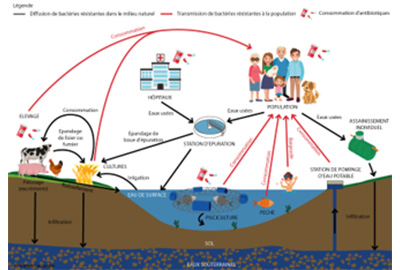SENSAAS
Projet SENSAAS
Développement de capteurs innovants de la contamination des eaux souterraines : impact et enjeux pour l’environnement et la santé humaine.
Projet Inter-axes I-SITE SENSors and Analyses for AquiferS
La qualité des eaux, et en particulier des eaux souterraines, utilisées prioritairement pour l’alimentation en eau potable (AFB, 2017) et alimentant les eaux de surface, est un enjeu à la fois environnemental et de santé publique. Si la variabilité des caractéristiques chimiques et biologiques des nappes peut différer, naturellement, selon les aquifères, elle peut être fortement accentuée par les activités humaines à la surface des bassins versants. Les premiers suivis des eaux souterraines sont menés dans les années 1970 pour évaluer ces impacts potentiels. Ils portent alors sur quelques critères physico-chimiques et biologiques, sans tenir compte de la contamination potentielle par les micropolluants, non quantifiables à cette époque.
Dans ce contexte, le projet SENSAAS propose le développement de capteurs et de méthodes de mesures innovants quantifiant des micropolluants d’intérêt sociétal (microplastiques, antibiotiques, métaux traces) dans les eaux souterraines :
Développement de méthodes de quantification innovantes de la teneur en microplastiques et de leurs compositions par relaxométrie et par pyrolyse couplée à la spectrométrie de masse (Pyro-CG-SM) : comparaison des résultats ;
Mise au point de matériaux à empreinte moléculaire pour doser des antibiotiques spécifiques (fluoroquinolones, macrolides, sulfamides) : comparaison avec les mesures acquises classiquement en LC-MSMS et articulation avec la quantification et la caractérisation des bactéries antibiorésistances ;
Optimisation du déploiement de fibre optique in situ pour caractériser les écoulements souterrains et quantifier les micropolluants métalliques.
En bref
- Hélène Celle
- Xavier Bertrand
- Philippe Amiotte-Suchet
- Thomas Karbowiak
- Jean-Charles Beugnot
- Kien Phan Huy
- Xavier Bertrand, Professeur des universités - praticien hospitalier (PU-PH) – UMLP, CHU Besançon, PATHOGENESxbertrand@-Code to remove to avoid SPAM-chu-besancon.fr, xbertran@-Code to remove to avoid SPAM-univ-fcomte.fr, +33 (0)3 70 63 21 36, bureau R+3 A8.1 (CHU)
- Hélène Celle, Professeure – UMLP, GEODE, GT E.A.U.helene.celle@-Code to remove to avoid SPAM-univ-fcomte.fr, +33 (0)6 33 59 01 04, bureau -132L (La Bouloie)
- UMR 6249 Chrono-Environnement (CNRS, UFC) – Porteur
- UMR 6174 FEMTO-ST (CNRS, UFC)
- UMR 6282 BioGéoSciences (CNRS, UB)
- UMR PAM, Procédés Alimentaires et Microbiologiques (AgroSup-Dijon, UB)
Le projet sera mis en place sur des sites appartenant aux services d’observation de l’UMLP, labélisés internationalement : Jurassic Karst (SNO Karst, ZAAJ, IR OZCAR, IR ZA, eLTER) et AUVERWATCH (SNO H+, SNO RENOIR, IR OZCAR, eLTER, GNIP-AIEA).






